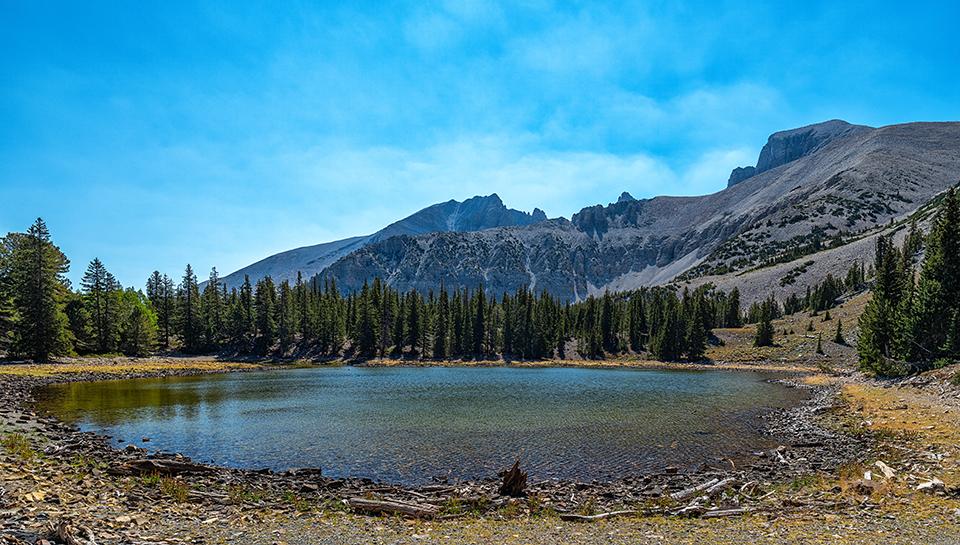
A late-summer view of Stella Lake landscape, Great Basin National Park / Rebecca Latson
I’ve wanted to visit Great Basin National Park for several years. I remember landing at McCarran International Airport in Las Vegas, picking up a rental car, and heading out to Zion or Bryce Canyon national parks, leaving Vegas behind and passing the sign pointing to the turnoff for Great Basin, some five hours away. I’d wonder, in passing, just when I might fit a trip to Great Basin in a future vacation plan. This 2021, the stars finally aligned for me to pack my cameras and drive to the park, albeit from a different direction than Vegas. I can definitely say Great Basin is a place you should add to your own national park photographic bucket list. Even in late summer.
After a full week in August at Yosemite National Park in California, a shorter stay immediately afterward in Great Basin National Park in Nevada felt downright uncrowded. Oh, it was still quite busy, given the time of year, but this national park’s location (kind of in the middle of nowhere) and smaller visitor infrastructure make it feel less crowded. That, despite the fact parking spaces for the more popular trailheads located along the highest elevations of Wheeler Peak Scenic Drive fill quickly and both sides of the (shoulder-less) road will be lined with cars by 10 a.m. Get there early in the morning, or much later in the afternoon/evening, though, and you’ll practically have the place to yourself, with plenty to photograph and nice light in which to do so.
The Great Basin is comprised of basin-and-range land: wide, flat, desert valleys with “no outlets to the sea,” surrounded by dry, rugged mountain ranges. Great Basin National Park’s 77,100 acres protect one such basin-and-range area: the South Snake Range. While the geology and ecosystem are different from, say, Big Bend National Park in Texas, Great Basin, like Big Bend, offers desert and high-elevation mountain views (in this case, 7,000-to-10,000+ feet elevation) for you and your camera.

Hummingbird in the flowers, Great Basin Visitor Center, Great Basin National Park / Rebecca Latson

Bumblebee on the beeweed, Great Basin Visitor Center, Great Basin National Park / Rebecca Latson
Since I’d never visited Great Basin before, I spent a portion of my first morning at the Great Basin Visitor Center just outside of the tiny community of Baker, Nevada. Next to the main building is a small flower garden of purple beeweed and sunny yellow arrowleaf balsamroot. Standing there with my telephoto lens, I spent a good 20-30 minutes alternately photographing a busy little hummingbird and the biggest, fuzziest, yellowest bumblebee I’d ever seen. What a great way to start the day! Of course, I had to use a camera with a fast fps (frame per second) shutter to freeze the constant movement of both bird and bee. I used a 100-400mm telephoto lens then cropped these images a little bit to bring the subjects even closer to the viewer. You can do the same thing with your telephoto setting on either smartphone or point-and-shoot, then crop when you edit the image.
During my three-day stay, sunrises were pretty impressive, even with (or perhaps because of) the smoky wildfire haze filtering in from neighboring California. If you visit, you can capture great morning shots regardless of whether you point your camera toward the east and the sun, or toward the west where the sunlight bathes the undulating mountains.
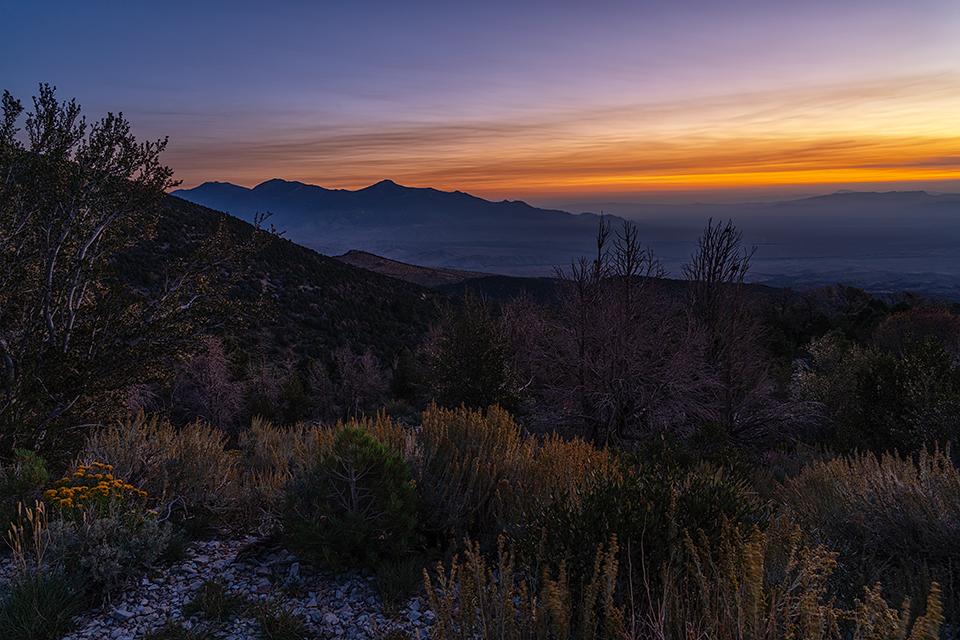
Awaiting sunrise along the Wheeler Peak Scenic Drive, Great Basin National Park / Rebecca Latson
The image above was captured at an unnamed pullout along narrow Wheeler Peak Scenic Drive, looking out over a part of Nevada and into Utah. Since I was setting up super-early that morning, I used a tripod to minimize camera shake blur. I also used my camera’s two-second timer to reduce the amount of vibration created when my finger pushed down on the shutter button. Note something else here, in this shot, and in other shots, actually: when photographing an area with trees or other vegetation, I try to compose the image such that I get as much of the entire tree or plant in the frame as possible. In relation to my subject matter. Sometimes, I can’t, but when I can, I do. This is sort of along the line of trying to photograph people without cutting off too much of their arms or legs from the frame.
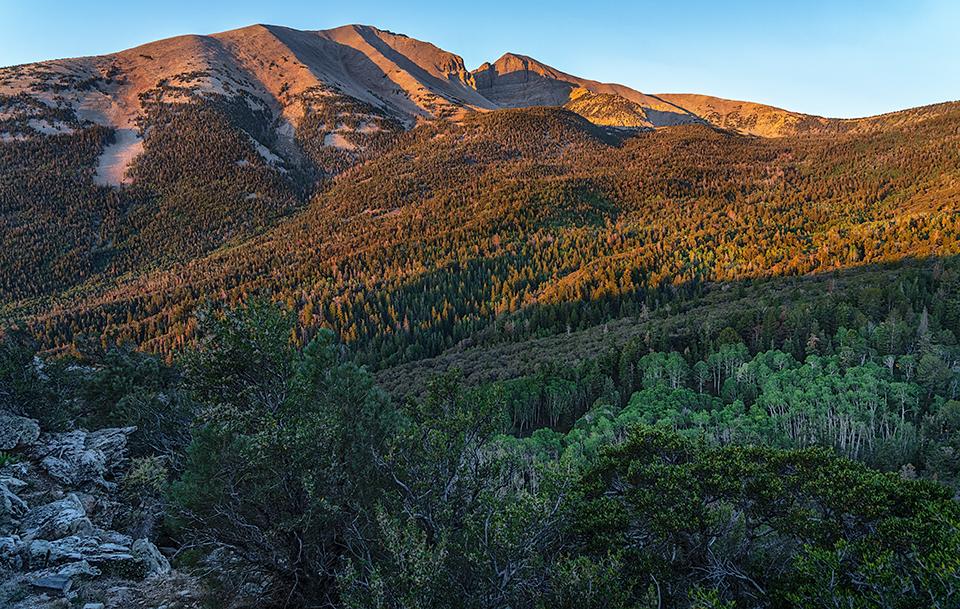
Sunrise At Mather Overlook, Great Basin National Park / Rebecca Latson
This image was photographed after I drove on to the gravel turnoff leading to Mather Overlook, for a view of the Wheeler Cirque and surrounding landscape bathed in golden light. In this instance, I handheld the camera since I couldn’t fit my tripod into the tight area between the permanent telescopes and a portion of the view area fencing.

Sunrise over Utah in the distance, Great Basin National Park / Rebecca Latson
I captured this sunrise image along the short gravel road leading from Wheeler Peak Scenic Drive to Mather Overlook. The views beyond the roadside bushes are just as amazing as the view toward Wheeler Cirque (to the right, outside of this composition).

The view along the Wheeler Peak Summit / Stella Lake Trail, Great Basin National Park / Rebecca Latson
After sunrise shots, I needed to drive on and secure a parking spot at one of the trailheads near the scenic road’s terminus. One day, I took the trail to Stella Lake, a nice 2.6-mile (roundtrip) hike over a narrow, uneven trail through stands of quaking aspen. Occasionally, I’d stop and face Wheeler Peak to photograph the view above and beyond all the trees.

The trail through the aspen trees, Great Basin National Park / Rebecca Latson
Because I love the leading line technique so much, I naturally captured a leading line shot of the trail through the white-barked, often curvy trunks of aspen. Leading lines created by trails encourage the viewer to imagine what adventure awaits at the end of the hike.
Depending upon when you visit Stella Lake, don’t be surprised if the lake looks more like a pond during the latter part of summer, especially if there have also been existing drought conditions in addition to the normal late summer heat. You can actually see a sort of “bathtub ring” around the lake, with darker grasses as well as bits and pieces of wood encircling the former lake level. That said, even during mid-morning, when the light starts to become harsh, the view is still lovely, as you can see from the very top photo of this article. Besides, you take what you are given at any particular time, right?
On another day, I got to the Bristlecone Trail parking lot early enough to snag a spot (around 6 a.m.) then headed out on another narrow, uneven, rocky, 2.8-mile roundtrip trail to one of the most accessible of the Great Basin Bristlecone groves – a hike that’s been on my bucket list for some time.

A Great Basin Bristlecone seen along the trail toward Bristlecone Grove, Great Basin National Park / Rebecca Latson

A summer morning at Bristlecone Grove, Great Basin National Park / Rebecca Latson

The bottlebrush shape of a Great Basin Bristlecone, Great Basin National Park / Rebecca Latson
To me, bristlecone pines are extremely photogenic, with their twisting trunks of alternating smooth and rough-barked wood and branches of bottlebrush needles. As a matter of fact, it’s those needles that helped me identify the difference between a bristlecone and neighboring Limber pine, which can be just as twisty as a bristlecone tree. Both grow side-by-side. When you visit this grove or hike to one of the other two bristlecone groves within the park, spare a moment to show respect to these ancient trees aged between 1,000 and over 4,000 years, and take your time composing your shots. Horizontal and vertical images both work well, since these trees are not anywhere as tall as giant sequoias or coastal redwoods. Growing at such high elevations (this grove sits over 10,000 feet in elevation) and in such a harsh environment, stunts the trees.
Sunsets are pretty special at Great Basin, as are blue hour and star shots. During my early September stay, the wildfire haze began to dissipate in the late afternoon, and sunset occurred around 7:00 p.m. and blue hour – that time of day before sunrise or after sunset when the sky and landscape are swathed in blues, mauves, and purples – followed sunset around 8 p.m. The stars didn’t really start popping into the indigo night sky until 9 p.m.
Had I stayed longer at this park, I would have tested different locations for sunset and star photography, maybe even at Stella Lake. Judging from other star shots I’ve seen at this lake, it’s a great place for stargazing, if you don’t mind picking your way along a narrow trail with packed rocks on top of which are loose rocks and snaking tree roots eager to trip you up.

The time between blue hour and total nighttime at Mather Point, Great Basin National Park / Rebecca Latson
As it was, I picked a spot I thought looked promising (Mather Overlook) and remained there from sunset onwards. I was not the only person who thought this place was a good one for stargazing. A van parked itself at the view area and chairs were set out for the coming star show.
To really capture the stars and Milky Way, you need to place your camera on a tripod to avoid camera shake blur. You also need to use manual focus instead of auto focus, because eventually, it will be too dark for the camera’s lens to focus on anything automatically. I used two tripods onto which I each placed a camera earlier that evening, while it was still light. I auto focused on the distant landscape and then flipped the manual focus switch. My cameras stayed where they were for the evening’s star shoot and I didn’t need to worry about fiddling with the manual focus ring on the lens.

The Milky Way at Mather Overlook, Great Basin National Park / Rebecca Latson
I’m an SLR gal because I like the level of control I have over camera settings as well as the amount of detail an SLR captures. I’m also a manual setting (as opposed to auto setting) kind of gal. For the night shots, I experimented with higher ISOs (800 to 4000), opened up the lens aperture (f3.5 – f2.8), and played around with shutter speeds from 10 seconds to 30 seconds. Because of the higher ISOs and wider aperture settings, the resulting images looked “noisy” (grainy – little bits of pink, green, and yellow grains) so I used noise reduction software to smooth things out and eliminate the grain as much as possible without making the entire composition look “plastic”.

Cave shield formations in Lehman Caves, Great Basin National Park / Rebecca Latson
When I took a guided tour through Lehman Caves (and you should definitely reserve a spot for a cave tour), I did the opposite of what you read in the paragraph above: I handheld the camera, since tripods are on a list of things you cannot take into the cave. How did I manage these shots? I increased the ISO to 2500, opened the aperture up to f4, but kept the shutter speed at 1/40 since there would be a little bit of artificial lighting in the cave, so I could fire off a series of shots using the burst method of holding my finger on the shutter button for several clicks. Usually, out of the three or four resulting images, one photo turned out nice and sharp. While editing the images, I again used noise reduction software. FYI, there are any number of noise removal software apps out there. Just type “noise reduction software” into your browser’s search engine to pull up sites listing software of varying prices and ease of use.
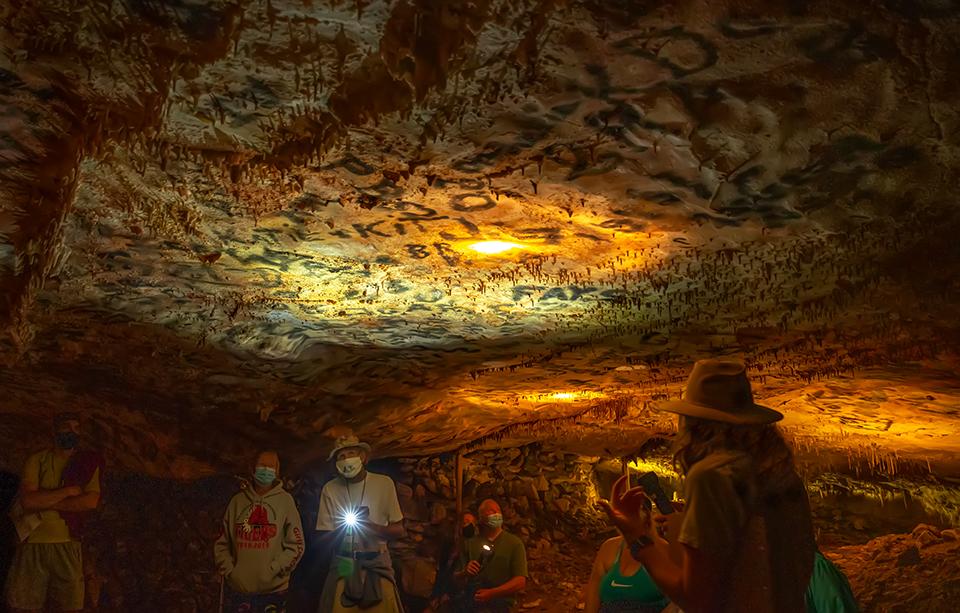
Gathered in the Inscription Room, Lehman Caves, Great Basin National Park / Rebecca Latson
You’ll notice I captured a photo in Lehman Caves with people in the shot. Sometimes, you should get a photo or two with people or some other human-made object in the frame. Why? Because people (or other evidence of people) add a sense of familiarity, scale, and reference to the scene.
Even in three short days at Great Basin National Park, I captured many cool shots, learned quite a bit about this park, and filled my days with plenty of activity. It takes some time to actually get to this park, and you need to make your camping or lodging reservations way ahead of time (read the Traveler’s Checklist for Great Basin), but it’s totally worth it. You can get great compositions. Even in late summer.
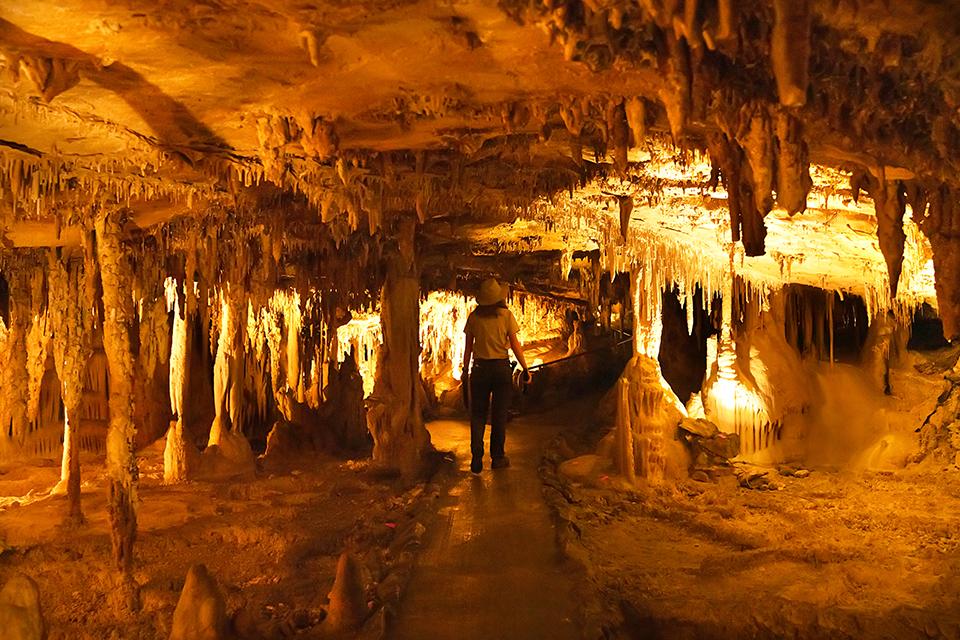
Following our tour guide Kelsey through Lehman Caves, Great Basin National Park / Rebecca Latson




 Support Essential Coverage of Essential Places
Support Essential Coverage of Essential Places







Comments
This was the surprise gem on a trip we took a few years ago. Many of my kids listed this as their favorite spot. Very limited camping, especially for RVs, but park was very quiet when we went. Would plan more time if we go again.
Great photos and article! I remember driving late fall one year through the scorching basin to get to the Park after visiting Cedar Breaks. Unfortunately, they closed Wheeler Peak Scenic Drive due to weather. So I just turned around and drove to Zion. I'd advise to check the road closures frequently or be disappointed as I was.
Another great article Rebecca - thanks for bringing this relatively unknown National Park to my attention.